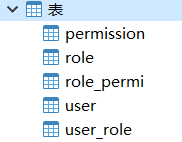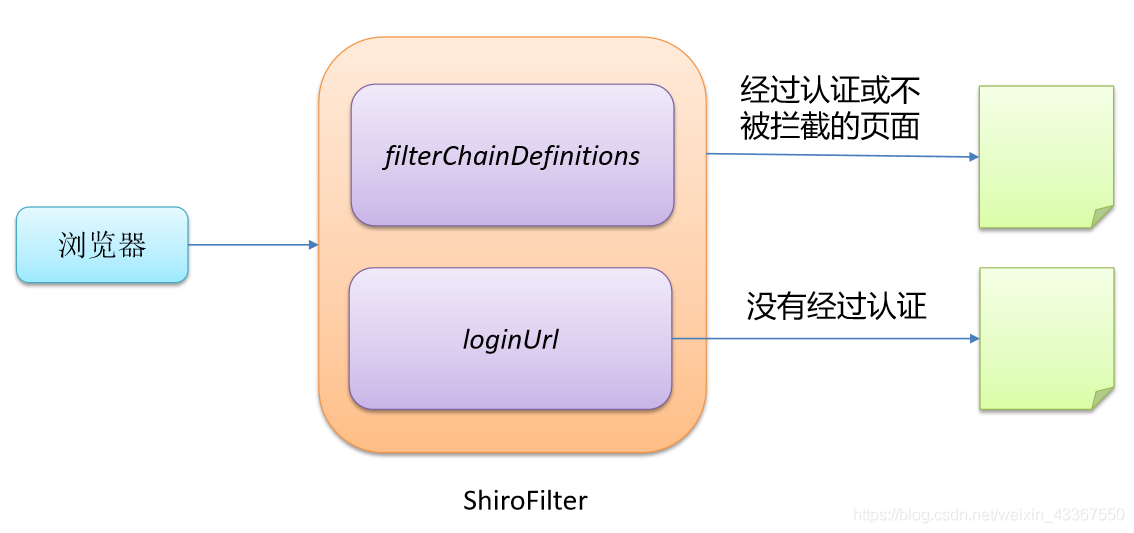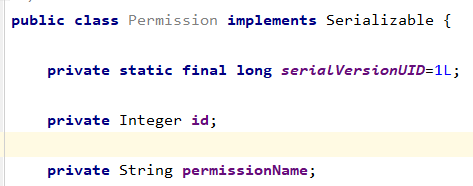Shiro
1. 功能简介
- Authentication:身份认证/登录,验证用户是不是拥有相应的身份;
- Authorization:授权,即权限验证,验证某个已认证的用户是否拥有某个权限;即判断用 户是否能进行什么操作,如:验证某个用户是否拥有某个角色。或者细粒度的验证某个用户 对某个资源是否具有某个权限;
- Session Manager:会话管理,即用户登录后就是一次会话,在没有退出之前,它的所有 信息都在会话中;会话可以是普通 JavaSE 环境,也可以是 Web 环境的;
- Cryptography:加密,保护数据的安全性,如密码加密存储到数据库,而不是明文存储;
- Web Support:Web 支持,可以非常容易的集成到Web 环境;
- Caching:缓存,比如用户登录后,其用户信息、拥有的角色/权限不必每次去查,这样可 以提高效率;
- Concurrency:Shiro 支持多线程应用的并发验证,即如在一个线程中开启另一个线程,能把权限自动传播过去;
- Testing:提供测试支持;
- Run As:允许一个用户假装为另一个用户(如果他们允许)的身份进行访问;
- Remember Me:记住我,这个是非常常见的功能,即一次登录后,下次再来的话不用登录了
2. Shiro架构
对外部而言:

- Subject:应用代码直接交互的对象是 Subject,也就是说 Shiro 的对外 API 核心就是 Subject。Subject 代表了当前“用户”, 这个用户不一定 是一个具体的人,与当前应用交互的任何东西都是 Subject,如网络爬虫, 机器人等;与 Subject 的所有交互都会委托给 SecurityManager; Subject 其实是一个门面,SecurityManager 才是实际的执行者;
- SecurityManager:安全管理器;即所有与安全有关的操作都会与 SecurityManager 交互;且其管理着所有 Subject;可以看出它是 Shiro 的核心,它负责与 Shiro 的其他组件进行交互,它相当于 SpringMVC 中 DispatcherServlet 的角色
- Realm:Shiro 从 Realm 获取安全数据(如用户、角色、权限),就是说 SecurityManager 要验证用户身份,那么它需要从 Realm 获取相应的用户 进行比较以确定用户身份是否合法;也需要从 Realm 得到用户相应的角色/ 权限进行验证用户是否能进行操作;可以把 Realm 看成 DataSource
对内部而言

- Subject:任何可以与应用交互的用户;
- SecurityManager :相当于SpringMVC 中的 DispatcherServlet;是 Shiro 的心脏; 所有具体的交互都通过 SecurityManager 进行控制;它管理着所有 Subject、且负责进 行认证、授权、会话及缓存的管理。
- Authenticator:负责 Subject 认证,是一个扩展点,可以自定义实现;可以使用认证策略(Authentication Strategy),判断什么情况下算用户认证通过了;
- Authorizer:授权器、即访问控制器,用来决定主体是否有权限进行相应的操作;即控制着用户能访问应用中的哪些功能;
- Realm:可以有 1 个或多个 Realm,可以认为是安全实体数据源,即用于获取安全实体的;可以是JDBC 实现,也可以是内存实现等等;由用户提供;所以一般在应用中都需要实现自己的 Realm;
- SessionManager:管理 Session 生命周期的组件;而 Shiro 并不仅仅可以用在 Web 环境,也可以用在如普通的 JavaSE 环境
- CacheManager:缓存控制器,来管理如用户、角色、权限等的缓存的;因为这些数据基本上很少改变,放到缓存中后可以提高访问的性能
- Cryptography:密码模块,Shiro 提高了一些常见的加密组件用于如密码加密/解密。
3. HelloWorld
官方HelloWorld
public class Quickstart {
private static final transient Logger log = LoggerFactory.getLogger(Quickstart.class);
public static void main(String[] args) {
// The easiest way to create a Shiro SecurityManager with configured
// realms, users, roles and permissions is to use the simple INI config.
// We'll do that by using a factory that can ingest a .ini file and
// return a SecurityManager instance:
// Use the shiro.ini file at the root of the classpath
// (file: and url: prefixes load from files and urls respectively):
Factory<SecurityManager> factory = new IniSecurityManagerFactory("classpath:shiro.ini");
SecurityManager securityManager = factory.getInstance();
// for this simple example quickstart, make the SecurityManager
// accessible as a JVM singleton. Most applications wouldn't do this
// and instead rely on their container configuration or web.xml for
// webapps. That is outside the scope of this simple quickstart, so
// we'll just do the bare minimum so you can continue to get a feel
// for things.
SecurityUtils.setSecurityManager(securityManager);
// Now that a simple Shiro environment is set up, let's see what you can do:
// get the currently executing user:
// 获取当前的 Subject. 调用 SecurityUtils.getSubject();
Subject currentUser = SecurityUtils.getSubject();
// Do some stuff with a Session (no need for a web or EJB container!!!)
// 测试使用 Session
// 获取 Session: Subject#getSession()
Session session = currentUser.getSession();
session.setAttribute("someKey", "aValue");
String value = (String) session.getAttribute("someKey");
if (value.equals("aValue")) {
log.info("---> Retrieved the correct value! [" + value + "]");
}
// let's login the current user so we can check against roles and permissions:
// 测试当前的用户是否已经被认证. 即是否已经登录.
// 调动 Subject 的 isAuthenticated()
if (!currentUser.isAuthenticated()) {
// 把用户名和密码封装为 UsernamePasswordToken 对象
UsernamePasswordToken token = new UsernamePasswordToken("lonestarr", "vespa");
// rememberme
token.setRememberMe(true);
try {
// 执行登录.
currentUser.login(token);
}
// 若没有指定的账户, 则 shiro 将会抛出 UnknownAccountException 异常.
catch (UnknownAccountException uae) {
log.info("----> There is no user with username of " + token.getPrincipal());
return;
}
// 若账户存在, 但密码不匹配, 则 shiro 会抛出 IncorrectCredentialsException 异常。
catch (IncorrectCredentialsException ice) {
log.info("----> Password for account " + token.getPrincipal() + " was incorrect!");
return;
}
// 用户被锁定的异常 LockedAccountException
catch (LockedAccountException lae) {
log.info("The account for username " + token.getPrincipal() + " is locked. " +
"Please contact your administrator to unlock it.");
}
// ... catch more exceptions here (maybe custom ones specific to your application?
// 所有认证时异常的父类.
catch (AuthenticationException ae) {
//unexpected condition? error?
}
}
//say who they are:
//print their identifying principal (in this case, a username):
log.info("----> User [" + currentUser.getPrincipal() + "] logged in successfully.");
//test a role:
// 测试是否有某一个角色. 调用 Subject 的 hasRole 方法.
if (currentUser.hasRole("schwartz")) {
log.info("----> May the Schwartz be with you!");
} else {
log.info("----> Hello, mere mortal.");
return;
}
//test a typed permission (not instance-level)
// 测试用户是否具备某一个行为. 调用 Subject 的 isPermitted() 方法。
if (currentUser.isPermitted("lightsaber:weild")) {
log.info("----> You may use a lightsaber ring. Use it wisely.");
} else {
log.info("Sorry, lightsaber rings are for schwartz masters only.");
}
//a (very powerful) Instance Level permission:
// 测试用户是否具备某一个行为.
if (currentUser.isPermitted("user:delete:zhangsan")) {
log.info("----> You are permitted to 'drive' the winnebago with license plate (id) 'eagle5'. " +
"Here are the keys - have fun!");
} else {
log.info("Sorry, you aren't allowed to drive the 'eagle5' winnebago!");
}
//all done - log out!
// 执行登出. 调用 Subject 的 Logout() 方法.
System.out.println("---->" + currentUser.isAuthenticated());
currentUser.logout();
System.out.println("---->" + currentUser.isAuthenticated());
System.exit(0);
}
}
个人入坑步骤(springboot)
整合方案
1.导入依赖
<dependency>
<groupId>org.apache.shiro</groupId>
<artifactId>shiro-spring</artifactId>
<version>1.5.0</version>
</dependency>
2.构建数据库和Javabean
-
权限
-
角色
-
用户
然后创建对应数据表,除去Javabean中的set类型字段。

尽管是一对多关系,但是为了显示清晰,我们使用中间表关联关系。
mapper查找用户,并返回他的角色以及权限
<select id="getUserByUsernameAndPsw" resultMap="user">
select
u.*,
r.*,
p.*
from user u
left join user_role ur
on ur.user_id=u.id
left join role r
on ur.role_id=r.rid
left join role_permi rp
on rp.role_id=r.rid
left join permission p
on rp.permi_id=p.pid
where u.username=#{username} and u.psw=#{psw}
</select>
<resultMap id="user" type="com.example.demo.web.entity.User">
<id column="id" property="id"/>
<result column="username" property="username"/>
<collection property="roles" resultMap="role"/>
</resultMap>
<resultMap id="role" type="com.example.demo.web.entity.Role">
<id column="rid" property="id"/>
<result column="role_name" property="roleName"/>
<collection property="permissions" ofType="com.example.demo.web.entity.Permission">
<id column="pid" property="id"/>
<result column="permission_name" property="permissionName"/>
</collection>
</resultMap>
MD5加密

4. 与Web集成
Shiro 提供了与 Web 集成的支持,其通过一个ShiroFilter 入口来拦截需要安全控制的URL,然后进行相应的控制
ShiroFilter 类似于如 Strut2/SpringMVC 这种 web 框架的前端控制器,是安全控制的入口点,其负责读取配置(如ini 配置文件),然后判断URL是否需要登录/权限等工作。
ShiroFilter工作原理

部分细节
- DelegatingFilterProxy 作用是自动到 Spring 容器查找名字为 shiroFilter(filter-name)的 bean 并把所有 Filter 的操作委托给它。
- [urls] 部分的配置,其格式是: “url=拦截器[参数],拦截 器[参数]”;
- 如果当前请求的 url 匹配 [urls] 部分的某个 url 模式,将会 执行其配置的拦截器。
- anon(anonymous) 拦截器表示匿名访问(即不需要登录即可访问)
- authc (authentication)拦截器表示需要身份认证通过后才能访问
Shiro默认的过滤器

URL匹配
匹配模式
- url 模式使用 Ant 风格模式
- Ant 路径通配符支持 ?、*、**,注意通配符匹配不包括目录分隔符“/”:
- ?:匹配一个字符,如 /admin? 将匹配 /admin1,但不匹配 /admin 或 /admin/;
- *:匹配零个或多个字符串,如 /admin 将匹配 /admin、 /admin123,但不匹配 /admin/1;
- **:匹配路径中的零个或多个路径,如 /admin/** 将匹 配 /admin/a 或 /admin/a/b
匹配顺序
- URL 权限采取第一次匹配优先的方式,即从头开始使用第一个匹配的 url 模式对应的拦截器链。 如:
- /bb/**=filter1
- /bb/aa=filter2
- /**=filter3
- 如果请求的url是“/bb/aa”,因为按照声明顺序进行匹 配,那么将使用 filter1 进行拦截。
5. 整合缓存
pom
<!--整合shiro缓存-->
<dependency>
<groupId>org.springframework.boot</groupId>
<artifactId>spring-boot-starter-cache</artifactId>
</dependency>
<dependency>
<groupId>net.sf.ehcache</groupId>
<artifactId>ehcache</artifactId>
</dependency>
<dependency>
<groupId>org.apache.shiro</groupId>
<artifactId>shiro-ehcache</artifactId>
<version>1.5.0</version>
</dependency>
ehcache.xml
<?xml version="1.0" encoding="UTF-8"?>
<ehcache updateCheck="false" dynamicConfig="false">
<diskStore path="java.io.tmpdir"/>
<cache name="users"
timeToLiveSeconds="300"
maxEntriesLocalHeap="1000"/>
<!--
name:缓存空间名称。
maxElementsInMemory:缓存最大个数。
eternal:对象是否永久有效,一但设置了,timeout将不起作用。
timeToIdleSeconds:设置对象在失效前的允许闲置时间(单位:秒)。仅当eternal=false对象不是永久有效时使用,可选属性,默认值是0,也就是可闲置时间无穷大。
timeToLiveSeconds:设置对象在失效前允许存活时间(单位:秒)。最大时间介于创建时间和失效时间之间。仅当eternal=false对象不是永久有效时使用,默认是0.,也就是对象存活时间无穷大。
overflowToDisk:当内存中对象数量达到maxElementsInMemory时,Ehcache将会对象写到磁盘中。
diskSpoolBufferSizeMB:这个参数设置DiskStore(磁盘缓存)的缓存区大小。默认是30MB。每个Cache都应该有自己的一个缓冲区。
maxElementsOnDisk:硬盘最大缓存个数。
diskPersistent:是否缓存虚拟机重启期数据 Whether the disk store persists between restarts of the Virtual Machine. The default value is false.
diskExpiryThreadIntervalSeconds:磁盘失效线程运行时间间隔,默认是120秒。
memoryStoreEvictionPolicy:当达到maxElementsInMemory限制时,Ehcache将会根据指定的策略去清理内存。默认策略是LRU(最近最少使用)。你可以设置为FIFO(先进先出)或是LFU(较少使用)。
clearOnFlush:内存数量最大时是否清除。
-->
<defaultCache name="defaultCache"
maxElementsInMemory="10000"
eternal="false"
timeToIdleSeconds="120"
timeToLiveSeconds="120"
overflowToDisk="false"
maxElementsOnDisk="100000"
diskPersistent="false"
diskExpiryThreadIntervalSeconds="120"
memoryStoreEvictionPolicy="LRU"/>
</ehcache>
ShiroConfig.java
/**
* 缓存管理器
* @return
*/
@Bean
public EhCacheManager ehCacheManager(){
EhCacheManager cacheManager = new EhCacheManager();
cacheManager.setCacheManagerConfigFile("classpath:ehcache.xml");
return cacheManager;
}
/**
* 开启注解模式,aop代理
* @return
*/
@Bean
@DependsOn("lifecycleBeanPostProcessor")
public DefaultAdvisorAutoProxyCreator defaultAdvisorAutoProxyCreator() {
DefaultAdvisorAutoProxyCreator defaultAdvisorAutoProxyCreator = new DefaultAdvisorAutoProxyCreator();
defaultAdvisorAutoProxyCreator.setProxyTargetClass(true);
return defaultAdvisorAutoProxyCreator;
}
/**
* 自定义realm
*
* @return
*/
@Bean
public UserRealm userRealm() {
UserRealm userRealm = new UserRealm();
userRealm.setCredentialsMatcher(hashedCredentialsMatcher());
userRealm.setCacheManager(ehCacheManager());
return userRealm;
}
/**
* 安全管理器注入缓存
*/
@Bean
public DefaultWebSecurityManager securityManager() {
DefaultWebSecurityManager securityManager = new DefaultWebSecurityManager();
securityManager.setRealm(userRealm());
securityManager.setCacheManager(ehCacheManager());
return securityManager;
}
EhcacheConfig
package com.bigdata.dangjian.web.config;
import org.springframework.cache.ehcache.EhCacheManagerFactoryBean;
import org.springframework.context.annotation.Bean;
import org.springframework.context.annotation.Configuration;
/**
* @author sxuer
*/
@Configuration
public class EhcacheConfig {
/**
* 设置为共享模式
* @return
*/
@Bean
public EhCacheManagerFactoryBean ehCacheManagerFactoryBean() {
EhCacheManagerFactoryBean cacheManagerFactoryBean = new EhCacheManagerFactoryBean();
cacheManagerFactoryBean.setShared(true);
return cacheManagerFactoryBean;
}
}
给realm类的service添加懒加载
UserRealm里注入的SysUserService等service,需要延迟注入,所以都要添加@Lazy注解(如果不加需要自己延迟注入),否则会导致该service里的@Cacheable缓存注解、@Transactional事务注解等失效。
public class UserRealm extends AuthorizingRealm {
@Autowired
@Lazy
IUserService userService;
/**
* 如果权限更改了,调用清理缓存
*/
public void clearCache() {
Subject currentUser = SecurityUtils.getSubject();
super.clearCache(currentUser.getPrincipals());
}
此时仅仅是缓存了权限认整,如果要对mybatis缓存,在对应方法/类上加
@CacheConfig(cacheNames = {"users"})
@Cacheable
视频临时笔记

 subject.login(token)的token,传递给了reaml(继承AuthenticatingReaml的类的AuthenticationInfo方法中)
subject.login(token)的token,传递给了reaml(继承AuthenticatingReaml的类的AuthenticationInfo方法中)

权限注解生成了代理对象,如果使用springAOP,也是通过代理实现的;
由于不允许代理的代理(会出现类型转换异常),因此,不要在AOP的地方进行shiro注解
Shiro session能够在service层获取session
setLoginUrl 设置的是控制器路径
调用login,进入AuthenticationInfo进行认证


个人总结
- Shiro在web主要用于登录认证和授权



